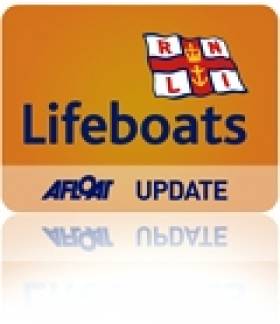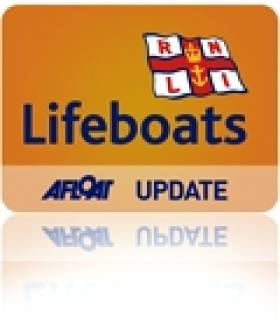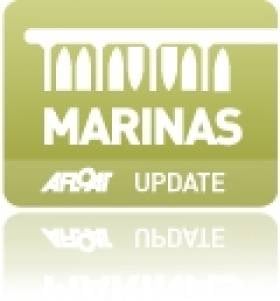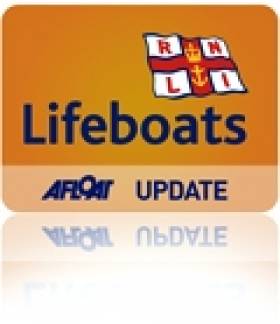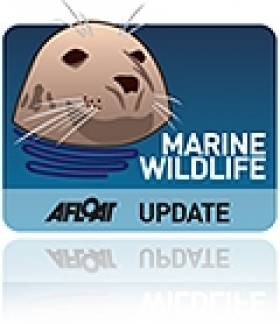Displaying items by tag: Strangford Lough
Crash With Turbine Caused Strangford Lough Yacht Dismasting
#RNLI - A collision with a tidal turbine was to blame for the incident that caused the dismasting of a yacht in Strangford Lough on Sunday 9 June.
As reported yesterday on Afloat.ie, Portaferry RNLI's lifeboat crew was dispatched to the stricken yacht in the narrows of Strangford Lough close to the SeaGen water turbine.
The local RNLI press office confirmed that three men and a teenage boy were on board the 37ft yacht at the time - though BBC News says that only three people were rescued, including a child.
The SeaGen installation in Strangford Lough was accredited by Ofgen as Britain's first tidal power plant, as previously reported on Afloat.ie.
#RNLI - Enniskillen RNLI today (10 June) brought four people to safety in two separate incidents on Lough Erne in Co Fermanagh.
In the first call-out of the day, the volunteer lifeboat crew retrieved a man and women from their stranded cruiser which had developed engine problems and run aground on Lower Lough Erne.
The inshore lifeboat Joseph and Mary Hiley and the Rescue Water Craft (RWC) were launched just before 10am at the request of Belfast Coastguard and made the 25-minute, six-mile journey to the casualty's last known position at Crunnish Island. The wind was coming from the south east, force five with good visibility.
On arrival at the scene, the crew noted the casualties had deployed their anchor and there were strong waves hitting the starboard side of the vessel.
The RWC crew member was transferred to the casualty vessel to reassure the crew and to check for any leakage. Another crew member from the lifeboat was transferred to assist with the tow and to lift the anchor.
The lifeboat established a tow and the vessel was refloated and brought to safety at Tudor Farm jetty, close to the initial location.
Less than three hours later, the inshore lifeboat Jason Logg was launched by request of Belfast Coastguard to rescue two people on a broken-down personal water craft on Upper Lough Erne.
The crew proceeded to the casualty's last known whereabouts at the mouth of Tamlagh Bay, four miles downstream from the station towards Enniskillen.
On arrival, the crew found the troubled vessel in the reeds with two people sitting on it. The crew transferred both passengers onto the lifeboat before setting up a tow and bringing the water craft back to Bellanaleck Marina.
Elsewhere in Northern Ireland, Portaferry RNLI brought three men and a teenage boy to safety yesterday afternoon after their yacht got into difficulty off Portaferry in Co Down.
The volunteer lifeboat crew was alerted just after noon following a mayday call that there was a demasted yacht in trouble on Strangford Lough.
The lifeboat was launched minutes later and was alongside the stricken vessel, a 37ft yacht located in the narrows of Strangford Lough, at 12.10pm. Weather at the time was good with clear visibility and a flat calm sea.
One of the four casualties, who had been thrown from the vessel, had been recovered by a fellow crew member and all four were on board the yacht when the lifeboat crew arrived on scene.
Alongside, there was difficulty recovering the vessel so the mast and sail were cut away. Once cut, the lifeboat proceeded to tow the yacht with it crew on board safely back to Strangford where it was tied to a mooring.
Two of the crew were conveyed to hospital while the other two were made comfortable on the shore.
Portaferry RNLI was requested to launch for a second time later this afternoon following a report that a swimmer had gone missing in Newtownards. The lifeboat having launched was subsequently stood down after the missing person was found safe and well.
Situated at the head of the Quoile River estuary on Castle Island. There is a short stay pontoon with water hose at Quoile Yacht Club. Visitors can anchor off the moored yachts between Castle and Gibbs Islands. No overnight berthing at the pontoon without permission.
RNLI Crews Assist Windsurfer, Stricken Fishing Boat in Co Down
#RNLI - Portaferry RNLI rescued a windsurfer who got into difficulty off the Co Down coast yesterday (16 April).
The volunteer crew launched their inshore lifeboat before 5pm yesterday evening to go the aid of the injured windsurfer reported to be in the area of Pig Island, a small island in Strangford Lough close to Newtownards Sailing Club.
The weather at the time was described as blowing slight to moderate winds with good visibility.
The crew was on scene at 5.15pm where they found the man on Pig Island accompanied by two other men. The windsurfer, who was suffering from a shoulder injury, was transferred to the lifeboat and made comfortable before being taken to the sailing club, where he was then transferred into the care of the coastguard and passed to the ambulance service to be taken to hospital.
Speaking after the rescue, Portaferry RNLI lifeboat operations manager Brian Bailie said: "As the charity that saves lives at sea, we will always respond to any call for help where someone is in danger.
"Strangford Lough is a popular destination for a wide range of water sport enthusiasts and it is important that they take all necessary precautions when using the lough.
"As we are all aware, accidents can and do happen and it is at such times that the work carried out by the volunteer crews of the RNLI is so important."
Elsewhere in Co Down yesterday, Bangor and Donaghadee RNLI assisted a fisherman whose 28ft commercial fishing boat experienced engine failure.
The crew quickly located the disabled boat one mile west of the Copeland Islands at the mouth of Belfast Lough yesterday morning after 11.15am.
With the vessel drifting closer to the island shores and the wind gusting gale force eight, a tow line was quickly rigged and passed to the fishing boat. Bangor RNLI was escorted by Donaghadee RNLI's all-weather lifeboat as it towed the fishing vessel to the safety of Bangor Harbour.
Bangor RNLI volunteer helm Peter Scott, who was involved in this rescue, said: "Engine failure close to shore could lead to a life threatening situation. We always urge everyone going to sea to make sure their electrical systems and engine are well maintained and in good working order. A good anchor and chain should always be carried as part of essential safety equipment.
"We are glad the skipper of this vessel is now safely ashore," he added.
Busy Days For RNLI Lifeboats In Co Down
#RNLI - Newcastle RNLI’s always-on-call lifeboat crew had to abandon their buckets and sponges during a fundraising car wash at the weekend to respond to an emergency at the Co Down town’s harbour.
The RNLI volunteers were busily soaping and rinsing cars for their annual Easter fundraiser on Saturday when they were alerted to a woman in trouble in the freezing water a few yards from one of the piers.
The car wash was immediately abandoned and within minutes the inshore lifeboat Aldergrove II was launched and rushed to the woman’s aid.
At the same time, crew member Shane Rice grabbed a lifebelt from the pier and jumped into the water to assist the woman. He kept her afloat while the Aldergrove II came alongside.
The woman was helped into the rescue inflatable, wrapped in blankets to prevent hypothermia, and taken back to shore where an ambulance was waiting to take her to hospital.
Newcastle RNLI’s deputy launching authority Clifford Moorehead said afterwards: "The lifeboat crew are always ready to respond in an instant to any emergency. It is fortunate that the car wash was in progress at the time and the crew members were on hand to swiftly deal with this case.
"After the rescue the crew members came back to the harbour and resumed their car wash. It’s just all in a day’s work for the RNLI."
It wasn't the only callout of the weekend for the RNLI in Co Down, as Bangor RNLI assisted a lone sailor who got into difficulty on a sailing dinghy Easter Sunday.
At 1.10pm the volunteer lifeboat crew received an urgent request from Belfast Coastguard to launch the lifeboat and rescue one person from a 17ft dinghy.
The sailing dinghy had reportedly gone aground on ‘Cockle Island’ off Groomsport Harbour on the southern shores of Belfast Lough.
Upon arrival at the scene, the volunteer crew found that the occupant onboard the dinghy had been assisted by another boat owner and the vessel had been safely tied to a mooring buoy.
Meanwhile, last Wednesday evening Portaferry RNLI was launched to reports that red flares has been sighted on Strangford Lough off Kircubbin in Co Down.
They were joined by a coastguard team that searched the shoreline and after some time recovered a spent flare casing. The inshore lifeboat and its volunteer crew were stood down after a number of hours with the callout proving to be a false alarm.
Portaferry RNLI lifeboat operations manager Brian Bailie said: "A member of the public acted in good faith ... alerting the emergency services to what they understood to be a distress flare on the lough."
He reiterated that flares "should only be used in emergency situations".
North and South RS Sailors Converge on Hospitable Strangford Lough Yacht Club
Fifteen RS 400s, from as far South as Glandore and as far North as Cushendall formed the main appetiser for the latest RS Ireland traveller series event. A smaller group of RS200s and RS Fevas also battled it out over the two days of the RS Northern Area Championships on glorious Strangford Lough. The racing came courtesy of the most hospitable of hosts at Strangford Lough Yacht Club and their team headed up by Emily Smith and Charlie Horder.
Saturday's racing was a blustery game of snakes and ladders with the RS 400 fleet continually trading blows and producing a different winner in each of the three races.
In the RS200's Heather Craig advised Trevor Fisher on how to do it, as they led overnight with three straight bullets.
In the Feva class, local boys Robbie and Peter Gilmore came good to lead overnight with an impressive score of 1, 3, 1.
The evening brought some "sensible drinking" and fine dining courtesy of event sponsors www.MashDirect.com . Rumours of some out of tune singing also circulated the following morning with some labelling it as Karaoke.
Sunday dawned a bit wet, but as the sun came out, it got even wetter for the back half of the RS 400 fleet as a whooping 30 knot right handed squall cuffed those taking too long to reach the windward mark in race 2, with entertaining variations on how not to bear off, hoist, gybe, stack it etc. Those who did set kites, (which was all but one) where treated to a somewhat out of control reach, (in which most helms would agree, they played very little part) as the mild mannered 400s decided they would steer themselves safely at 20 knots to the downwind position some 200 metres to the right of the last mark. Much swimming was done. There was a welcome rest whilst the PRO rearranged the course for the final race, in lovely sunshine, with some cheeky puffs that allowed all to arrive ashore nicely enthralled by the day's activity.
In the final mix, the Ballyhome duo of Bob "The Laser" Espey and Michael "The other Laser" Gunning took top spot by in RS400 class. Five different winners in six races showed that it was no push over for the lads.
In the RS200 class Heather Craig and Trevor Fisher had the luxury of discarding a second place, the only blot on an otherwise perfect score card to round out a clinical win.
In the Feva class Robbie and Peter Gilmore continued with Saturdays fine form with a 2,1,1 score to take a decisive victory. Perhaps Santa might have to squeeze an RS200 down the Gilmore chimney this year!
Next up for the Irish RS Classes is Greystones and the Sothern Championship on 6th and 7th of October. The local contingent will no doubt be ready to repel the Northern invaders, who are currently very much growing in strength and numbers.
Invasive Sea Squirt May Be in Strangford Lough
#MARINE WILDLIFE - The Northern Ireland Environmental Agency (NIEA) has indicated the possible presence of Japanese sea squirt on the bed of Strangford Lough, as the Press Associaton reports.
Experts are attemping to confirm the identity of the invasive organism that has posed a threat to mussel and scallop populations across the Irish Sea in north Wales.
The sea creature, Didemnum vexillum, spreads like a blanket across the seabed and other surfaces, smothering shellfish and other marine life in the process. It is often transported over large distances on boat hulls and fishing equipment.
It was discovered late last year in Holyhead marina, and Welsh athorities spent £250,000 on an extermination project to prevent its spread into the Menai Strait - at the heart of the region's shellfish industry.
Dr Rohan Holt, a senior scientist from the Countryside Council for Wales, has now been called in to advise on how to manage the threat should it indeed be confirmed as the Japanese sea quirt.
Meanwhile, members of the public have been urged to report any possible sightings of Japanese sea squirt with photos through the 'Alien Watch' section of the Invasive Species Ireland website.
The Press Association has more on the story HERE.
Northern Ireland Marine Bill Discussed at Special Workshop
#MARINE WILDLIFE - A meeting of the Northern Ireland Marine Task Force (NIMTF) last week brought together interests from across the spectrum to discuss the new Marine Bill and ensure it will "deliver for all sea users".
The workshop at Castle Espie on Strangford Lough last Thursday 22 March saw politicians sit down with environmentalists, fishermen and wind farm developers, and engage with those responsible for drafting the proposed legislation.
According to a statement from the Ulster Wildlife Trust, which is a member of the NIMTF, the bill "provides for the creation of a network of marine protected areas to protect marine wildlife" as well as a roadmap for a more joined-up approach to the North's marine resources.
NIMTF spokesperson Ricky Devlin said: "We now need to ensure that [the bill] addresses the full range of environmental, recreational and commercial interests such as fishing, diving, electricity generation and aquaculture."
A full report of the meeting will be available shortly from www.nimtf.org
NI Faces Big Fine Over Horse Mussels
#MARINE WILDLIFE - Northern Ireland faces a whopping £8 million (€9.6 million) fine from the EU over its failure to protect horse mussels.
According to BBC News, "little has been done" to protect horse mussel reefs in Strangford Lough despite promises from two government departments as far back as six years ago.
Last year Afloat.ie reported on a study from Queen's University Belfast that revealed the extent of damage to horse mussel reefs in the lough by fishing activity.
Strangford Lough is officially protected as a Special Conservation Area and a Marine Nature Reserve, as well as an Area of Special Scientfic Interest, but as BBC News states, "in reality there has been little protection put in place".
Horse mussels are pivotal to the lough's ecosystem, as some 100 other species rely on the reefs formed by the mussels in the seabed for their habitat.
NI officials now have just a few months to persuade the European Commission that they are taking strong action to protect the species, otherwise they will be charged with breaking EU directives.
BBC News has more on the story HERE.


























